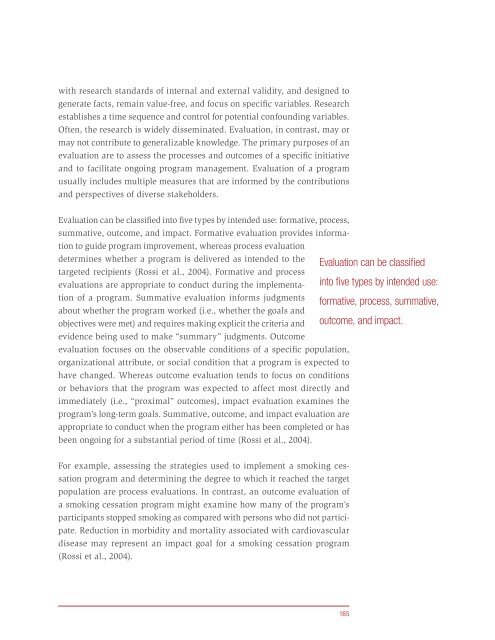Principles of Community Engagement (Second Edition)
Principles of Community Engagement (Second Edition)
Principles of Community Engagement (Second Edition)
Create successful ePaper yourself
Turn your PDF publications into a flip-book with our unique Google optimized e-Paper software.
with research standards <strong>of</strong> internal and external validity, and designed to<br />
generate facts, remain value-free, and focus on specific variables Research<br />
establishes a time sequence and control for potential confounding variables<br />
Often, the research is widely disseminated Evaluation, in contrast, may or<br />
may not contribute to generalizable knowledge The primary purposes <strong>of</strong> an<br />
evaluation are to assess the processes and outcomes <strong>of</strong> a specific initiative<br />
and to facilitate ongoing program management Evaluation <strong>of</strong> a program<br />
usually includes multiple measures that are informed by the contributions<br />
and perspectives <strong>of</strong> diverse stakeholders<br />
Evaluation can be classified into five types by intended use: formative, process,<br />
summative, outcome, and impact Formative evaluation provides information<br />
to guide program improvement, whereas process evaluation<br />
determines whether a program is delivered as intended to the<br />
targeted recipients (Rossi et al , 2004) Formative and process<br />
evaluations are appropriate to conduct during the implementation<br />
<strong>of</strong> a program Summative evaluation informs judgments<br />
about whether the program worked (i e , whether the goals and<br />
objectives were met) and requires making explicit the criteria and<br />
evidence being used to make “summary” judgments Outcome<br />
evaluation focuses on the observable conditions <strong>of</strong> a specific population,<br />
organizational attribute, or social condition that a program is expected to<br />
have changed Whereas outcome evaluation tends to focus on conditions<br />
or behaviors that the program was expected to affect most directly and<br />
immediately (i e , “proximal” outcomes), impact evaluation examines the<br />
program’s long-term goals Summative, outcome, and impact evaluation are<br />
appropriate to conduct when the program either has been completed or has<br />
been ongoing for a substantial period <strong>of</strong> time (Rossi et al , 2004)<br />
For example, assessing the strategies used to implement a smoking cessation<br />
program and determining the degree to which it reached the target<br />
population are process evaluations In contrast, an outcome evaluation <strong>of</strong><br />
a smoking cessation program might examine how many <strong>of</strong> the program’s<br />
participants stopped smoking as compared with persons who did not participate<br />
Reduction in morbidity and mortality associated with cardiovascular<br />
disease may represent an impact goal for a smoking cessation program<br />
(Rossi et al , 2004)<br />
Evaluation can be classified<br />
into five types by intended use:<br />
formative, process, summative,<br />
outcome, and impact.<br />
165

















